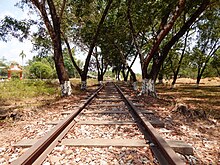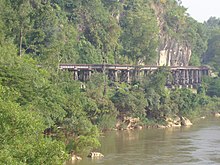ทางรถไฟสายมรณะ
( Burma Railway )
The Burma Railway, also known as the Siam–Burma Railway, Thai–Burma Railway and similar names, or as the Death Railway, is a 415 km (258 mi) railway between Ban Pong, Thailand, and Thanbyuzayat, Burma (now called Myanmar). It was built from 1940 to 1943 by civilian laborers impressed or recruited by the Japanese and prisoners of war taken by the Japanese, to supply troops and weapons in the Burma campaign of World War II. It completed the rail link between Bangkok, Thailand, and Rangoon, Burma. The name used by the Japanese Government was Tai–Men Rensetsu Tetsudō (泰緬連接鉄道), which means Thailand-Burma-Link-Railway.
Between 180,000 and 250,000 Southeast Asian civilians and over 60,000 Allied prisoners of war were subjected to forced labour during its construction. Around 90,000 civilians died, as did more than 12,000 Allied prisoners.
Most o...Read more
The Burma Railway, also known as the Siam–Burma Railway, Thai–Burma Railway and similar names, or as the Death Railway, is a 415 km (258 mi) railway between Ban Pong, Thailand, and Thanbyuzayat, Burma (now called Myanmar). It was built from 1940 to 1943 by civilian laborers impressed or recruited by the Japanese and prisoners of war taken by the Japanese, to supply troops and weapons in the Burma campaign of World War II. It completed the rail link between Bangkok, Thailand, and Rangoon, Burma. The name used by the Japanese Government was Tai–Men Rensetsu Tetsudō (泰緬連接鉄道), which means Thailand-Burma-Link-Railway.
Between 180,000 and 250,000 Southeast Asian civilians and over 60,000 Allied prisoners of war were subjected to forced labour during its construction. Around 90,000 civilians died, as did more than 12,000 Allied prisoners.
Most of the railway was dismantled shortly after the war. Only the first 130 kilometres (81 mi) of the line in Thailand remained, with trains still running as far north as Nam Tok.
 Map of the Burma Railway
Map of the Burma RailwayA railway route between Burma and Thailand, crossing Three Pagodas Pass and following the valley of the Khwae Noi river in Thailand, had been surveyed by the British government of Burma as early as 1885, but the proposed course of the line – through hilly jungle terrain divided by many rivers – was considered too difficult to undertake.[1]
Thailand was a neutral country at the onset of World War II. On 8 December 1941, Japan invaded Thailand, which quickly surrendered.[2][3] Thailand was forced to accept an alliance,[4] and was used as a staging point for the attack on Singapore.[5]
In early 1942, Japanese forces invaded Burma and seized control of the colony from the United Kingdom. To supply their forces in Burma, the Japanese depended upon the sea, bringing supplies and troops to Burma around the Malay peninsula and through the Strait of Malacca and the Andaman Sea. This route was vulnerable to attack by Allied submarines, especially after the Japanese defeat at the Battle of Midway in June 1942. To avoid a hazardous 2,000-mile (3,200 km) sea journey around the Malay peninsula, a railway from Bangkok to Rangoon seemed a feasible alternative.[6] The Japanese began this project in June 1942.[7]
 The British government sold the Thai section of Burma railway to the Thai government for a total of 50 million baht
The British government sold the Thai section of Burma railway to the Thai government for a total of 50 million baht Abandoned section of Burma Railway in Thanbyuzayat, Myanmar (Burma)
Abandoned section of Burma Railway in Thanbyuzayat, Myanmar (Burma)The project aimed to connect Ban Pong in Thailand with Thanbyuzayat in Burma, linking up with existing railways at both places. Its route was through Three Pagodas Pass on the border of Thailand and Burma. 69 miles (111 km) of the railway were in Burma and the remaining 189 miles (304 km) were in Thailand. The movement of POWs northward from Changi Prison in Singapore and other prison camps in Southeast Asia began in May 1942.[8] On 23 June 1942, 600 British soldiers arrived at Camp Nong Pladuk, Thailand to build a camp to serve as a transit camp for the work camps along the railway.[9][10] After preliminary work of airfields and infrastructure, construction of the railway began in Burma and Thailand on 16 September 1942.[11][12] The projected completion date was December 1943.[8] Much of the construction materials, including tracks and sleepers, were brought from dismantled branches of Malaya's Federated Malay States Railway network and the East Indies' various rail networks.[13][14][15]
 The Wang Pho Viaduct built by rōmusha and POWs on the railway
The Wang Pho Viaduct built by rōmusha and POWs on the railwayThe railway was completed ahead of schedule. On 17 October 1943, construction gangs originating in Burma working south met up with construction gangs originating in Thailand working north. The two sections of the line met at kilometre 263, about 18 km (11 mi) south of the Three Pagodas Pass at Konkoita (nowadays: Kaeng Khoi Tha, Sangkhla Buri District, Kanchanaburi Province).[16] A holiday was declared for 25 October which was chosen as the ceremonial opening of the line.[17][18] The Japanese staff would travel by train C56 31 from Nong Pladuk, Thailand to Thanbyuzayat, Burma. A copper spike was driven at the meeting point by commanding General Eiguma Ishida, and a memorial plaque was revealed.[18]
As an American engineer said after viewing the project, "What makes this an engineering feat is the totality of it, the accumulation of factors. The total length of miles, the total number of bridges – over 600, including six to eight long-span bridges – the total number of people who were involved (one-quarter of a million), the very short time in which they managed to accomplish it, and the extreme conditions they accomplished it under. They had very little transportation to get stuff to and from the workers, they had almost no medication, they couldn't get food let alone materials, they had no tools to work with except for basic things like spades and hammers, and they worked in extremely difficult conditions – in the jungle with its heat and humidity. All of that makes this railway an extraordinary accomplishment."[19]
The Japanese Army transported 500,000 tonnes of freight[citation needed] over the railway before it fell into Allied hands.
Post-warOn 16 January 1946, the British ordered Japanese POWs to remove a four-kilometre stretch of rail between Nikki (Ni Thea) and Sonkrai.[20][21] The railway link between Thailand and Burma was to be separated again for protecting British interests in Singapore.[20] After that, the Burma section of the railway was sequentially removed, the rails were gathered in Mawlamyine, and the roadbed was returned to the jungle.[20]
In October 1946, the Thai section of the line was sold to the Government of Thailand for £1,250,000 (50 million baht; equivalent to US$55,161,760 in 2021).[22][23] The money was used to compensate neighbouring countries and colonies for material stolen by Japan during the construction of the railway.[22] On 1 February 1947, two people—including Momluang Kri Dechatiwong, the Thai Minister of Transport—were killed on an inspection tour because the bridge near Konkoita had collapsed.[24][25] After the accident, it was decided to end the line at Nam Tok and reuse the remainder to rehabilitate the line.[26]
After the war, the railway was in poor condition and needed reconstruction for use by the Royal Thai Railway system. On 24 June 1949, the portion from Kanchanaburi to Nong Pla Duk (Thai หนองปลาดุก) was finished; on the first of April 1952, the next section up to Wang Pho (Wangpo) was done. The two curved spans of the bridge which collapsed due to the British air attack were replaced by angular truss spans provided by Japan as part of their postwar reparations, thus forming the iconic bridge now seen today. Finally, on 1 July 1958, the rail line was completed to Nam Tok (Thai น้ำตก, 'waterfall', referring to the nearby Sai Yok Noi Waterfall) The portion in use today is some 130 km (81 mi) long. The line was abandoned beyond Nam Tok Sai Yok Noi;[26][21] the steel rails were salvaged for reuse in expanding the Bang Sue railway yard, reinforcing the Bangkok–Ban Phachi Junction double track, rehabilitating the track from Thung Song Junction to Trang, and constructing both the Nong Pla Duk–Suphan Buri and Ban Thung Pho–Khiri Rat Nikhom branch lines. Parts of the abandoned route have been converted into a walking trail.[27]
 The first locomotive used for goods transport on the Death Railway on display in Thanbyuzayat, Myanmar
The first locomotive used for goods transport on the Death Railway on display in Thanbyuzayat, MyanmarSince the 1990s various proposals have been made to rebuild the complete railway, but as of 2021[update] these plans had not been realised. Since the upper part of the Khwae valley is now flooded by the Vajiralongkorn Dam,[18] and the surrounding terrain is mountainous, it would take extensive tunnelling to reconnect Thailand with Burma by rail.
 The start point in Myanmar
The start point in Myanmar

























Add new comment